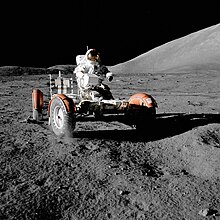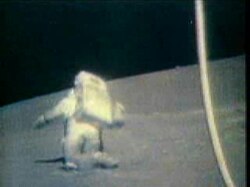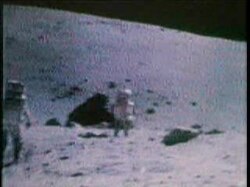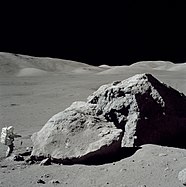Apollo 17
| Mission emblem | |||||||
|---|---|---|---|---|---|---|---|
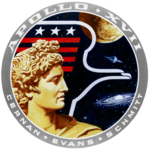
|
|||||||
| Mission dates | |||||||
| Mission: | Apollo 17 | ||||||
| COSPAR-ID : | 1972-096A | ||||||
| Command module: | CM-114 (from North American Rockwell ) | ||||||
| Service module: | SM-114 (from Grumman Aerospace Corporation ) | ||||||
| Lunar Module: | LM-12 | ||||||
| Dimensions: | Take-off mass: 48,607 kg Landing mass: 5,500 kg |
||||||
| Launcher: |
Saturn V , serial number SA-512 |
||||||
| Call sign: | CM: America LM: Challenger |
||||||
| Crew: | 3 | ||||||
| Begin: | December 7, 1972, 05:33:00 UTC JD : 2441658.73125 |
||||||
| Starting place: | Kennedy Space Center , LC-39A | ||||||
| Number of EVA : | 3 | ||||||
| Moon landing: | December 11, 1972, 19:54:57 UTC JD : 2441663.3298264 |
||||||
| Landing place moon: | Taurus - Littrow , 20 ° 11 '26.88 " N , 30 ° 46' 18.05" O , IAU coordinate system | ||||||
| Length of the lunar EVAs: | 22h 3m 57s | ||||||
| Time on the moon: | 3d 2h 59m 40s | ||||||
| Start from the moon: | December 14, 1972 JD : 2441665.5 |
||||||
| Lunar orbits: | 75 | ||||||
| Time in lunar orbit: | 6d 3h 43m 37s | ||||||
| Rotation time : | about 120 min | ||||||
| Orbit inclination : | 159.9 ° | ||||||
| Landing: | December 19, 1972, 19:24:59 UTC JD : 2441671.3090162 |
||||||
| Landing place: |
Pacific 17 ° 53 ′ S , 166 ° 7 ′ W |
||||||
| Flight duration: | 12d 13h 51m 59s | ||||||
| Earth orbits: | 2 on the flight to the moon 1 on return |
||||||
| Recovery ship: | USS Ticonderoga | ||||||
| Rotation time : | 87.83 min | ||||||
| Orbit inclination : | 28.526 ° | ||||||
| Apogee : | 171.3 km | ||||||
| Perigee : | 168.9 km | ||||||
| Team photo | |||||||
 Apollo 17 - v. l. No. Harrison Schmitt , Eugene Cernan , Ronald Evans |
|||||||
| ◄ Before / After ► | |||||||
|
|||||||
Apollo 17 was the eleventh manned flight in the Apollo program and the last manned flight to the moon to date . The mission started on December 7, 1972 at 12:33 a.m. Eastern Standard Time from the Kennedy Space Center in Florida . On board were the commander Eugene Cernan , the pilot of the Apollo spacecraft Ron Evans and the pilot of the lunar module Harrison "Jack" Schmitt .
Apollo 17 was the first night launch in US manned space travel and the last launch of the Apollo program with a Saturn V rocket . While Evans was in lunar orbit in the Apollo command module, Cernan and Schmitt spent almost three days on the moon in the Taurus-Littrow Valley. They took three spacewalks (extravehicular activity, EVA), withdrawals moon rock samples and used the Apollo Lunar Surface Experiments Package ( ALSEP ) on the lunar surface. Evans carried out scientific measurements and took photographs of the lunar orbit using a module attached to the service module. The landing site for Apollo 17 was chosen with the primary aim of examining lunar rocks from a highlands older than the effects that formed the Mare Imbrium .
The Apollo 17 moon landing was the sixth and last of the Apollo program; it was also the last time that humans traveled beyond low-earth orbit . It was also the first flight to the moon where the commander was not a test pilot, and the first without a test pilot on board. The X-15 test pilot Joe Engle had been replaced by Harrison Schmitt. The mission broke records for longest stay on the moon, longest EVAs, largest lunar sample, and longest time in lunar orbit .
Cernan, Evans and Schmitt returned to Earth on December 19, 1972 after twelve days. After Apollo 17, remaining Apollo spacecraft were used in the Skylab and Apollo-Soyuz programs. The next manned flight to the moon is planned for 2022 with the US mission Artemis 2 , the next landing for 2024 with Artemis 3 .
crew

On August 13, 1971, shortly after the Apollo 15 flight , NASA announced the crew for the Apollo 17 mission. According to the schedule, it would have been the turn of the Apollo 14 substitute team to move up to the main team. The nomination of Eugene Cernan as commander and Ron Evans as pilot of the Apollo command module America was in itself no surprise, but the nomination of Cernan was briefly in question because he had caused a helicopter to crash through a daring flight maneuver and thus his personal one Suitability as commander of a space flight was discussed. Instead of Joe Engle , however, Harrison Schmitt from the Apollo 15 backup team was assigned to pilot the Challenger lunar module. Schmitt was one of the science astronauts selected by NASA in 1965, none of whom had yet been deployed. Under pressure from NASA scientists, Schmitt was given preference over Engle.
The entire Apollo 15 crew was initially assigned as a substitute team: Commander David Scott , command module pilot Alfred Worden and lander pilot James Irwin . This was completely replaced as a result of the postage stamp affair in May 1972. Commander and lunar module pilot of Apollo 16 , John Young and Charles Duke jumped in, as the pilot of the command module of Apollo 14, Stuart Roosa .
The support crew consisted of the science astronaut Robert Parker as well as Gordon Fullerton and Robert Overmyer , who had received their astronaut training with the US Air Force and switched to NASA after the Air Force had planned their own manned space program ( Manned Orbiting Laboratory , MOL).
Mission insignia
The mission badge shows the head of the Greek sun god Apollo on a midnight blue background in front of the light blue outlines of an eagle, the heraldic animal of the United States. In the outline of the eagle, under three white five-pointed stars, there are four red horizontal stripes. Stars and stripes quote the flag of the United States ; the three stars also represent the three crew members. In the background the moon, the planet Saturn and a galaxy or a nebula can be seen. The wing of the eagle partially covers the moon and thus indicates the presence of humans there. Apollo's gaze and the direction of the eagle's movement embody the intention of humanity to explore further destinations in space.
In addition to the colors of the US flag (red, white and blue), the missons badge contains the color gold, which stands for a golden age of space travel that should begin with the moon landing of Apollo 17.
The head of Apollo is an image of an ancient sculpture, the " Apollo of Belvedere ". The badge was designed by Robert McCall ; the team brought their ideas into the design.
preparation
The individual stages of the Saturn V rocket AS-512 were delivered to Cape Kennedy between October 1970 and June 1972 . The Apollo spacecraft CSM-114 was named America , the lunar module LM-12 was named Challenger (challenger) .
On August 28, 1972, the rocket could be rolled to launch pad 39-A.
Liaison officers ( Capcom ) during the flight were Young, Duke and Roosa from the backup crew, Parker, Fullerton and Overmyer from the support team, Alan Shepard from Apollo 14, Ken Mattingly from Apollo 16, and Joseph Allen , a science astronaut who was with Apollo 15 Capcom.
Planning and training
Like Apollo 15 and Apollo 16, Apollo 17 was referred to as the J mission , a type of Apollo mission that involved three days of lunar surface stays, more extensive scientific activities, and the use of the Lunar Roving Vehicle. Since Apollo 17 was supposed to be the last moon landing of the Apollo program, suitable landing sites, which had not previously been considered, were now subjected to a closer examination. A landing in Copernicus crater was considered, but this was ultimately rejected because Apollo 12 had already collected samples from this crater and three further Apollo landings had already been carried out near Mare Imbrium . A landing in the lunar highlands near the Tycho crater was also considered, but was discarded because of the terrain found there and a landing on the back of the moon . At Tsiolkovskiy Crater , additional communication satellites would have been necessary for a landing to ensure the connection between the ground crew and the landing team, which would have made the mission much more expensive. A landing in a region southwest of Mare Crisium was also considered, but this was rejected on the grounds that a Soviet spacecraft could easily reach the place; Luna 20 was supposed to land near Apollo 17 a week later. After a selection, three locations remained for the landing of Apollo 17: the Alphonsus Crater , the Gassendi Crater and the Taurus-Littrow Valley . In making the final decision, the mission planners considered the primary goals for Apollo 17: obtaining ancient highland material from a considerable distance from Mare Imbrium, sampling recent volcanic activity (less than three billion years old), and with minimal overlap of soil samples from the Apollo missions 15 and Apollo 16 to maximize the amount of new samples. All landing sites except Taurus-Littrow were ruled out for scientific or technical reasons. Landing at Tycho was considered too dangerous because of the rough terrain.
The crew should be able to obtain samples of ancient highland material from the remains of a landslide that occurred on the south face of the valley and the possibility of geologically young material derived from volcanic activity in the area. Although the valley was similar to the Apollo 15 landing site, which sits on the edge of the moon's dark plains , the advantages of Taurus - Littrow were believed to outweigh the disadvantages, which led to its selection as the landing site for Apollo 17. Apollo 17 was the only moon landing mission that carried out the Traverse Gravimeter Experiment (TGE), an experiment developed by the Draper Laboratory at the Massachusetts Institute of Technology (MIT), to take relative gravitational measurements during the landing on site and at different locations during the stay deliver on the lunar surface. The scientists would then use this data to gather information about the geological substructure of the landing site and the surrounding area.
As with the previous moon landings, the astronauts went through an extensive training program that included training on collecting samples on the surface, using the spacesuits , navigation in the lunar roving vehicle, field geology training, survival training, dumping and recovery with the landing capsule, and training with the equipment.
Flight history
begin

The launch took place on December 7, 1972 at 5:33 UTC . Apollo 17 was the last manned space flight with a Saturn V rocket. The Apollo 17 mission was originally scheduled to begin at 2:53 UTC. However, the countdown had to be canceled 30 seconds before the scheduled time because a computer failed. This should put the liquid oxygen tank of the third stage ( S-IVB ) of the Saturn V under pressure. After a delay of more than two hours and forty minutes, the missile lifted off the launch pad. This start delay was the only one in the entire Apollo program that was caused by a hardware failure.
Despite the night time, an estimated 500,000 people watched the launch in the immediate vicinity of the Kennedy Space Center. Due to the darkness, the start of Apollo 17 could still be seen from 800 km away. Many people in Miami, Florida saw a red line crossing the northern sky.
At 8:46 UTC, the third stage was re-ignited to accelerate the spacecraft towards the moon.
At 19:47 UTC on December 10, the Service Propulsion System (SPS) of the service module fired to slow the CSM / LM into lunar orbit . After the orbit adjustment and the orbital stabilization, the crew began landing in the Taurus-Littrow valley.
Blue marble
On the way to the moon, the crew succeeded in taking the famous picture of a “full earth” “ Blue Marble ” with a view of Africa and the Indian Ocean. This constellation came about because the intended landing site was the easternmost of the Apollo program; the requirement for a favorable, not too high standing sun on the moon therefore led to a start only 34 hours after the new moon .
On the moon
Cernan and Schmitt landed with the lunar module "Challenger" north of Mons Vitruvius at a foothill of the Mare Serenitatis . The astronauts were supposed to conduct three EVAs on this mission. The "Apollo lunar surface experiment package" ( ALSEP ), equipped with a radionuclide battery , was set up during the first EVA ("Extravehicular Activity", activity outside the lander) near the landing site, a little further away than the remaining experiments. The test and measurement systems included in detail:
- A heat flow experiment
- A gravimeter profile measurement
Apollo 17 was the only Apollo mission that carried out the Traverse Gravimeter Experiment (TGE). Since gravimeters had proven useful in geologically studying the earth, the aim of this experiment was to use the same techniques on the moon to explore its internal structure. The gravimeter was used to obtain readings at the landing site in the immediate vicinity of the lunar module (LM), as well as at various locations on the routes of the LRV during the mission. Measurements with the TGE were carried out on the Lunar Roving Vehicle by the astronauts when it was stationary or the TGE was placed on the lunar surface. A total of twenty-six measurements were made with the TGE during the mission at the three EVAs. As part of the Apollo Lunar Surface Experiments Package (ALSEP), the astronauts also used the Lunar Surface Gravimeter, a similar experiment that ultimately did not work properly.
- Flash of light phenomenon
During the Apollo lunar missions, crew members observed flashes of light. These flashes, described as streaks or spots, were observed by astronauts during a sleep period when the spacecraft was darkened. About two flashes per minute were observed. This phenomenon did not occur on the lunar surface; it was observed by the crew members during the flight to the moon, back to earth and in lunar orbit. Like the crew of Apollo 16, the Apollo 17 crew carried out an experiment aimed at clarifying the connection between the flashes of light and cosmic rays . As part of the experiment, conducted by NASA and the University of Houston , an astronaut wore a device that recorded the time, strength, and path of high-energy particles. The analysis showed that the experiment supported the hypothesis that the flashes observed are charged particles that penetrate the eye through the retina .
- A gravimeter rate measurement
- A meteorite counter
- Systems for ground electrical measurements
- Systems for soil mechanics experiments
- Devices for atmospheric measurements
- Cosmic Ray Detectors
- A detector and a source for neutrons
- A transponder for measuring gravity
- Active seismometer experiments
Day 1:
The Apollo 17 mission's first walk on the moon (EVA) began on December 11 at 23:55 UTC, about four hours after landing. The first task was to unload the required equipment and other equipment from the lander. In addition, the proven Lunar Roving Vehicle (moon car) was put into operation, which, in contrast to the previous missions, had no defects in the steering . However, the rear right wheel cover partially broke off when Cernan got caught with a hammer under the right fender, so that moondust flew on the drivers and significantly obstructed their view. The Apollo 16 commander John Young caused similar damage during the Apollo 16 mission when walking around the rover.
Cernan and Schmitt made repairs using lunar maps and adhesive tape as well as clips that were misused from the interior lighting of the lunar module. A moon map was taped onto the damaged fender, but the dust that accumulated on the surface of the fender prevented them from affixing the map properly. After consulting Mission Control , a better method of applying the tape resulted in a satisfactory solution and the repair lasted until the end of the mission. The crew then began the planned experiments with the ALSEP west of the immediate landing site. Afterward, Cernan and Schmitt went to the steno crater south of the landing site, the mission's first geological survey to collect 14.3 kilograms (31 pounds) of rock samples. They took seven gravimeter readings and positioned two explosive packages that were later detonated remotely to take geophone measurements taken by the astronauts on the previous Apollo missions. This EVA ended after seven hours and twelve minutes.
Day 2:
The next day an expedition was undertaken in a westerly direction to various craters , including Shorty Crater , where Schmitt found Orange Soil , orange-colored beads made of a glass-like material, which he commented with audible enthusiasm. After 7 hours and 36 minutes, the EVA was terminated. On that day, 34.1 kg of material were collected.
Day 3:
The last excursion, during which 62 kg of rock and core samples were recovered, took the crew to several craters northeast of the lander and lasted 7 hours and 15 minutes. The EVA, the last of the Apollo program, began on December 13 at 10:26 p.m. UTC. During this expedition, the crew collected 66 kg of lunar rock and carried out nine gravimeter measurements. They drove the rover to the north and east of the landing site and explored the base of the north massif, the sculpture hill and the unusual lunar crater Van Serg . Before the end of the lunar walk, the crew collected a rock, a breccia, and dedicated it to several nations that were then represented at the Mission Control Center in Houston, Texas. A plaque on the lunar module commemorating the achievements of the Apollo program was unveiled by the astronauts. Cernan then followed Schmitt into the lunar module after spending about 7 hours and 15 minutes on the lunar surface.
The astronauts covered a total of 34 kilometers with their moon car. They climbed several craters and the Taurus Mountains and collected a total of 110.4 kg of lunar rock for transport back to earth , including the lunar basalt 70017 and the troctolite 76535 . It was the longest mission in the Apollo series with 3 days and 3 hours on the moon.

On December 14, 1972 at 05:40 UTC, Cernan was the last person to leave the lunar surface, which has not been re-entered by humans to this day. He said goodbye with the words:
“I'm on the surface; and, as I take man's last step from the surface, back home for some time to come - but we believe not too long into the future - I'd like to just [say] what I believe history will record. That America's challenge of today has forged man's destiny of tomorrow. And, as we leave the Moon at Taurus-Littrow, we leave as we came and, God willing, as we shall return, with peace and hope for all mankind. Godspeed the crew of Apollo 17. ”
“I'm on the surface; and if I am to take a man's last step from the moon towards home for some time, then I would like to say what I think history will hold: America's challenge of today has forged the fate of man tomorrow. We are now leaving Taurus-Littrow as we once came and, if God willing, we will return in peace and hope for all of humanity. Have a good trip for the crew of Apollo 17. "
The transmission of the restart from the moon with the remote-controlled camera succeeded perfectly this time. The training of the two previous missions made it possible to control the panning of the camera in such a way that the ascent level remained almost in the center of the image, despite the signal run time of a total of 2.5 seconds.
In the meantime, the Apollo spaceship, which remained in lunar orbit, examined the lunar surface, as an extension of earlier missions with an active radar. The orbit was very similar to that of Apollo 15, so that the data obtained could be supplemented and correlated. From this, important elements such as the tectonic structure of the lunar crust could be determined with high accuracy. The cameras of the SM also expanded the image material on the moon.
Return to earth
After Cernan and Schmitt had switched back to the Apollo spacecraft, the ascent stage of the lunar module was deliberately brought down. It hit about 10 km away from the descent step that was left behind. The triggered moonquake was not only registered by the seismometers at the landing site of Apollo 17, but also by the still functional ones of Apollo 12, 14, 15 and 16.
The explosive charges installed by the astronauts for the active seismic experiment (ASE) were detonated remotely in the following days.
Also on this return flight there was an EVA to recover film material. Evans spent 66 minutes outside of America . On December 19, 1972, the astronauts blew up the service module that was no longer required. The command capsule entered the earth's atmosphere and at 19:24 UTC the Apollo 17 crew with the command capsule watered in the Pacific . Cernan, Evans and Schmitt were recovered by a rescue helicopter ( Sikorsky S-61 ) and were safely aboard the USS Ticonderoga 52 minutes after landing .
Whereabouts of the spacecraft
The command module is now located in the Lyndon B. Johnson Space Center in Houston , Texas . The ascent stage of the Lunar Module Challenger ( 20 ° 11 '26.88 " N , 30 ° 46' 18.05" O ) left with the two astronauts on December 15, 1972 at 6:50 UTC the moon, the descent stage remained on the moon at the landing site ( 19 ° 57 ′ 36 ″ N , 30 ° 30 ′ 0 ″ E ) of Apollo 17.
In 2009 and 2011, the Lunar Reconnaissance Orbiter photographed the Apollo 17 landing site from deeper orbits. The photos show the astronauts' footpaths and tire tracks from the rover.
Trivia
- Portions of the Apollo 17 mission are featured in the HBO miniseries from the 1998 From the Earth to the Moon episode entitled Le Voyage dans la Lune .
- The prologue of the 1999 book Back to the Moon by Homer Hickam begins with a dramatized depiction of the end of the second Apollo 17 EVA. The Orange Soil then becomes the main subject of the plot for the rest of the story.
- The released Thriller in 2005 Tyrannosaur Canyon by Douglas Preston opens with a presentation of the Apollo 17 EVAs using quotes from the official Missionstranskript.
- In addition, there have been fictional astronauts in film, literature, and television who have been described as The Last Man to Walk on the Moon . One such character was astronaut Steve Austin in the television series The Six Million Dollar Man . In the 1972 novel Cyborg , on which the series is based, Austin recalls watching Earth ... fall as Apollo XVII
- In the 1998 film Deep Impact , Robert Duvall plays the fictional astronaut Spurgeon "Fish" Tanner. The President of the United States referred to him at a press conference as The Last Man to Walk on the Moon, and the President was portrayed in the film by Morgan Freeman .
- In the Japanese anime series Aldnoah.Zero , the Apollo 17 mission found an old transporter gate (Hypergate) on the back of the moon in 1972 , through which mankind began to colonize Mars. This discovery is the point of divergence for an alternate story.
multimedia
Harrison Schmitt falls while walking on the moon.
Harrison Schmitt sings I was strolling on the Moon one day .
Challenger's ascent stage started from the surface of the moon
Lunar Orbiter 4 in the Taurus-Littrow Valley near the landing site
A model of the UV spectrometer with which the first precise measurements of the components of the lunar atmosphere were carried out
Landing site of Apollo 17, image from Lunar Reconnaissance Orbiter in 2009
Significance for the Apollo program
The originally planned missions Apollo 18 , 19 and 20 were canceled before Apollo 15 for both political and financial reasons. The USA has completed a successful program with six moon landings and twelve US astronauts who left their mark on the earth's satellite .
The Soviet Union has for other, even later successes never adequate technology (see N1 realized) for a manned moon landing. Its successor state Russia intends to reach the moon with modified Soyuz spaceships and the PTK NP .
Web links
- Start of the Apollo 17 from the moon ( QuickTime video, 1 MiB)
- NASA: Apollo 17 Info (English)
- NASA: Apollo 17 Lunar Surface Journal (English)
- NASA: Apollo 17 Mission Report (PDF, 24 MB, 349 pages, English)
- Apollo 17 Command and Service Module (CSM) in the NSSDCA Master Catalog (English)
- Image of the Apollo 17 landing site , astronews.com
Individual evidence
- ↑ a b c d Apollo 17 in the Encyclopedia Astronautica (English)
- ↑ a b c Apollo 17 Landing Site Overview (English)
- ↑ Extravehicular Activity of Apollo 17 ( Memento of November 18, 2004 in the Internet Archive ) (English)
- ↑ NASA biography of Harrison Schmitt (English; PDF)
- ↑ Apollo Mission Insignias ( Memento from July 21, 2011 in the Internet Archive ) (English)
- ↑ a b Apollo 17 Traverse Gravimeter Experiment Apollo Lunar Surface Journal (English)
- ↑ The Incredible Things NASA Did to Train Apollo Astronauts (English)
- ↑ Apollo 17 Launch Operations (English)
- ↑ a b c Apollo 17 Press Kit (PDF), Washington DC: NASA. November 26, 1972 ( Memento of September 2, 2014 in the Internet Archive ) (English)
- ↑ Apollo Light Flash Investigations - Biomedical Results of Apollo ( Memento from July 21, 2011 in the Internet Archive ) (English)
- ↑ ALSEP Off-load , Apollo Lunar Surface Journal ( Memento from August 16, 2015 in the Internet Archive ) (English)
- ↑ Moondust and Duct Tape , Science @ NASA, Brzostowski, Matthew; Brzostowski, Adam (English)
- ↑ The First EVA , Apollo Lunar Surface Journal ( Memento from July 16, 2011 in the Internet Archive ) (English)
- ↑ Eugene Cernan: The last man on the moon on spiegel.de
- ↑ EVA-3 close-out. In: Apollo 17 Lunar Surface Journal. NASA, September 4, 2011, accessed November 16, 2012 .
- ^ Return to Earth , Apollo 17 Lunar Surface Journal, NASA
- ↑ a b Apollo: Where are they now? , NASA (English)
- ^ NASA Spacecraft Images Offer Sharper Views of Apollo Landing Sites , NASA. Goddard Release No. 11-058 (co-issued as NASA HQ Release No. 11-289) (English)
- ↑ Traces on the moon on sueddeutsche.de
- ↑ From the Earth to the Moon - Season 1, Episode 12: Le Voyage Dans La Lune , TV.com, San Francisco, CA: CBS
- ↑ Hickam, Homer H., Jr. (1999). Back to the moon. New York: Delacorte Press. ISBN 0-385-33422-2
- ↑ Anderson, Patrick (September 19, 2005), Rex Marks the Spot , The Washington Post
- ^ Martin Caidin (1972), Cyborg, New York: Arbor House, ISBN 0-87795-025-3




